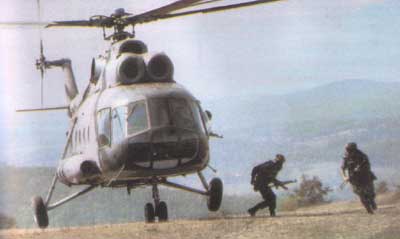Operation
Čapljina, 1992
Despite wrong decisions, acts and omissions, as well as incompetence of some Yugoslav People's Army (JNA) unit commanders during the 1991 and 1992 conflicts, there still were examples and acts in which enviable battle skills, competent commanding, courage and daring of participating JNA troops were demonstrated.
These
missions were carried out mainly by special squads, paratroops, scouting and
diversionary groups and military and police units, who demonstrated high standards
of skill. One such mission was the rescue operation of troops from the besieged
barracks at Čapljina. The operation of 23 April 1992 was carried out by a
combat task force composed of JNA Air Force pilots and members of the 63rd
Parachute Brigade, who had previously been given a combat assignment in Mostar.
Nine Mi-8 helicopters took part, but only eight landed in the barracks precinct,
while the ninth was kept in reserve, hovering in the close proximity.
On that 23rd April 1992, six choppers took off from the Mostar Jesenice Helicopter
Airfield, and three from the Ortiješ Pad. The crew of each craft included
two pilots and a mechanic, all volunteering for the mission. In addition,
there were 25 parachutists in the choppers, whose task was to secure, protect
and assist the boarding and pullout of the troops under siege. They were all
conscious of the dangers, high risk and possible serious losses in the action,
aware, however, that the troops surrounded at the ^apljina Barracks, who had
been under incessant pressure and fire from Croat and Muslim forces, must
be rescued as swiftly as possible. The action, therefore, had a purely defensive
and humanitarian character.
Intensive artillery preparation of the assault commenced at 16:45 hours and lasted until 17:00 hours. The Mi-8's took off concurrently with the commencement and duration of the artillery "pounding", as the flight from Mostar to ^apljina was supposed to take an estimated 15 to 16 minutes. The choppers were escorted and protected by Air Force and Air Defence aircraft. According to the plan, the evacuation of the troops from the moment of landing of the choppers, to the assembling and boarding of the men, to takeoff of the last craft, was to take 12 minutes, as it was deemed that the enemy would need that long to overcome the initial surprise and organize a counterattack. It was also supposed to allow the troops in the barracks enough time to assemble and carry their materiel to the choppers.
The action only took 7.5 minutes. After landing within the perimeter of the barracks, eight choppers and 16 parachutists assembled and pulled out 170 troops and civilians, who had for over two weeks been under fire from the assailants. This mission was also record setting in the number of people carried by an Mi-8, as one of them accommodated 43 troops, whereby all estimates until then as to the transportation capacity of this type of aircraft were denied. Even all their equipment - backpacks, bags, weapons… had to be discarded from some of the choppers for the purpose…
The choppers returned to Mostar without loss, although all had been "pierced",
and it was no small wonder that there had been no casualties, or that none
of the aircraft had been downed or compelled to make a forced landing by reason
of damage. True, one chopper returned with only one motor, but still it reached
its destination and delivered the troops unharmed. For security reasons and
prevention of a "leak", the Čapljina Barracks command had only been
informed of the evacuation ten minutes prior to landing, namely when the choppers
had already been in the air, and on their way to Čapljina. In devising the
action plan losses of the intervention group had been anticipated. Fortunately,
this did not take place thanks primarily to the swift execution and good organization
of the action, which took the enemy by surprise by its boldness. Thus it was
verified that good intelligence preparation and preservation of secrecy were
essential to the success of the operation.
Great
courage, self-sacrifice and daring of the parachutists and helicopter crews
alike, who put their lives at stake in order to rescue their comrades from
the barracks under siege, from an almost hopeless situation, are to be highly
commended.


